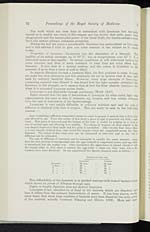Alexander Fleming (1881-1955)
Lysozyme: President's address
72
Proceedings of the Royal Society of Medicine
2
The work which has been done in connection with lysozyme has certainly
caused us to modify our views in this respect and has shown that quite apart from
phagocytosis and the bactericidal power of the blood fluids, the tissues and secretions
have also certain primary antiseptic properties.
During the last ten years a considerable literature has accumulated on lysozyme
and in this address I wish to give you some account of the subject as it stands
to-day.
Properties of lysozyme.—Lysozyme has the characters of a ferment. The
rapidity of its action increases up to 60° C, but at temperatures over 65° C. it is
destroyed more or less rapidly. In certain conditions it will withstand boiling for
some minutes, and thus is more resistant to heat than are some other body
ferments. It acts best in a neutral medium and the action is inhibited by the
presence of more than a trace of acid or alkali.
As regards filtration through a bacterial filter, the first portions to come through
are quite free from lysozyme and this originally led me to believe that it was held
back by ordinary bacterial filters. However, when large amounts of lysozyme-
containing material were filtered it was found that the later samples contained the
lysozyme in full strength, so it appears that at first the filter absorbs lysozyme but
when it is saturated lysozyme passes freely.
Lysozyme is not dialysable through parchment (Wolff, 1927).
Baker showed that the rate of destruction of lysozyme by ultra-violet light was
approximately the same as that of ferments, e.g., trypsin, and was widely different
from the rate of destruction of the bacteriophage.
Lysozyme is very readily diffusible in ordinary nutrient agar and its rate of
diffusion is identical with that of trypsin. This can easily be seen in the following
manner:—
Agar containing sufficient coagulated serum to make it opaque is poured into a Petri dish
and allowed to set. From the centre of this plate a piece of agar is punched out with a cork
borer. This piece is removed and the bottom of the hole is sealed by putting in a drop or
two of melted agar and allowing it to solidify. Two drops of trypsin are then placed in the
cup-shaped depression thus made and the plate is incubated. After twenty-four hours there
is a very sharply defined clear zone round the trypsin where the coagulated serum has been
digested. The extent of this clear zone can be measured at intervals and so the rate of
diffusion can be estimated.
The rate of diffusion of lysozyme can be measured in exactly the same manner, except
that the test microbe is incorporated into the agar instead of coagulated serum, and egg-white
is introduced into the central cup. After incubation the appearance is almost identical with
the trypsin plate in that there is around the egg-white a clean-cut clear zone where the
bacteria have been dissolved. In one experiment the figures obtained were as follows :—
| Diameter of clear zone | |||||
| Lysozyme | Trypsin | ||||
| 18 tours | ... | ... | 23 mm. | ... | 24 mm. |
| 2 days | ... | ... | 29 ,, | ... | 30 ,, |
| 3 ,, | ... | ... | 33 ,, | ... | 34 ,, |
| 4 ,, | ... | ... | 38 ,, | ... | 38 ,, |
| 6 ,, | ... | ... | 42 ,, | ... | 42 ,, |
This diffusibility of the ferments is in marked contrast with that of bacteriophage
which shows no power of diffusion through agar.
Peptic or tryptic digestion does not destroy lysozyme.
Lysozyme is not absorbed by or fixed to the bacteria which are dissolved and
here it differs from the ordinary bacteriolysin of serum. It has been shown, on the
other hand, that when large numbers of bacteria have been dissolved the lytic power
of the material actually increases (Fleming and Allison, 1922). More and more


